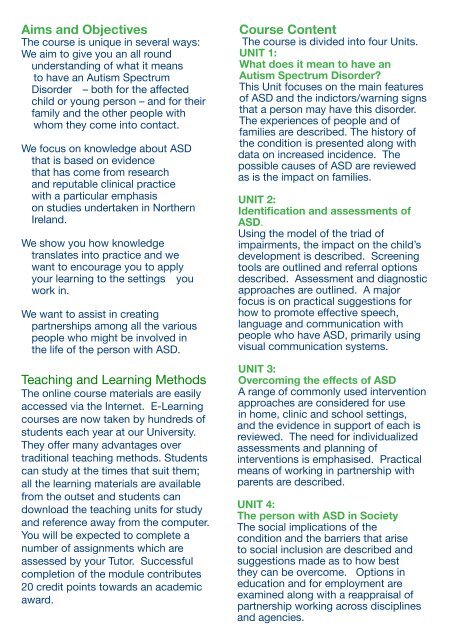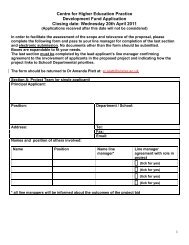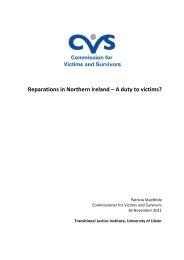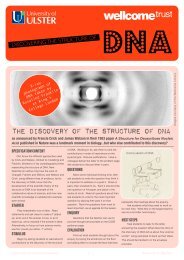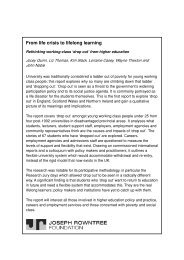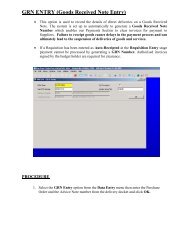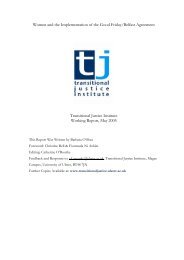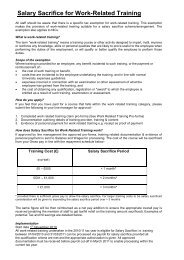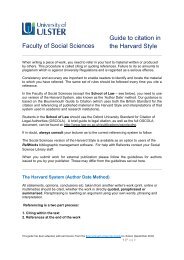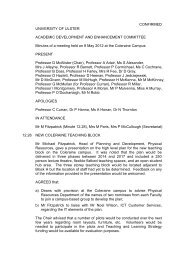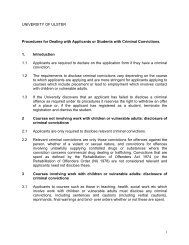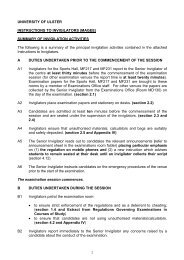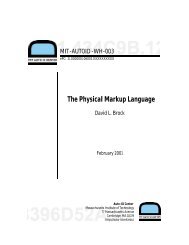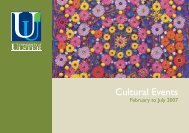Foundation Studies in Autism Spectrum Disorders - University of Ulster
Foundation Studies in Autism Spectrum Disorders - University of Ulster
Foundation Studies in Autism Spectrum Disorders - University of Ulster
You also want an ePaper? Increase the reach of your titles
YUMPU automatically turns print PDFs into web optimized ePapers that Google loves.
Aims and Objectives<br />
The course is unique <strong>in</strong> several ways:<br />
We aim to give you an all round<br />
understand<strong>in</strong>g <strong>of</strong> what it means<br />
to have an <strong>Autism</strong> <strong>Spectrum</strong><br />
Disorder – both for the affected<br />
child or young person – and for their<br />
family and the other people with<br />
whom they come <strong>in</strong>to contact.<br />
We focus on knowledge about ASD<br />
that is based on evidence<br />
that has come from research<br />
and reputable cl<strong>in</strong>ical practice<br />
with a particular emphasis<br />
on studies undertaken <strong>in</strong> Northern<br />
Ireland.<br />
We show you how knowledge<br />
translates <strong>in</strong>to practice and we<br />
want to encourage you to apply<br />
your learn<strong>in</strong>g to the sett<strong>in</strong>gs you<br />
work <strong>in</strong>.<br />
We want to assist <strong>in</strong> creat<strong>in</strong>g<br />
partnerships among all the various<br />
people who might be <strong>in</strong>volved <strong>in</strong><br />
the life <strong>of</strong> the person with ASD.<br />
Teach<strong>in</strong>g and Learn<strong>in</strong>g Methods<br />
The onl<strong>in</strong>e course materials are easily<br />
accessed via the Internet. E-Learn<strong>in</strong>g<br />
courses are now taken by hundreds <strong>of</strong><br />
students each year at our <strong>University</strong>.<br />
They <strong>of</strong>fer many advantages over<br />
traditional teach<strong>in</strong>g methods. Students<br />
can study at the times that suit them;<br />
all the learn<strong>in</strong>g materials are available<br />
from the outset and students can<br />
download the teach<strong>in</strong>g units for study<br />
and reference away from the computer.<br />
You will be expected to complete a<br />
number <strong>of</strong> assignments which are<br />
assessed by your Tutor. Successful<br />
completion <strong>of</strong> the module contributes<br />
20 credit po<strong>in</strong>ts towards an academic<br />
award.<br />
Course Content<br />
The course is divided <strong>in</strong>to four Units.<br />
UNIT 1:<br />
What does it mean to have an<br />
<strong>Autism</strong> <strong>Spectrum</strong> Disorder?<br />
This Unit focuses on the ma<strong>in</strong> features<br />
<strong>of</strong> ASD and the <strong>in</strong>dictors/warn<strong>in</strong>g signs<br />
that a person may have this disorder.<br />
The experiences <strong>of</strong> people and <strong>of</strong><br />
families are described. The history <strong>of</strong><br />
the condition is presented along with<br />
data on <strong>in</strong>creased <strong>in</strong>cidence. The<br />
possible causes <strong>of</strong> ASD are reviewed<br />
as is the impact on families.<br />
UNIT 2:<br />
Identification and assessments <strong>of</strong><br />
ASD.<br />
Us<strong>in</strong>g the model <strong>of</strong> the triad <strong>of</strong><br />
impairments, the impact on the child’s<br />
development is described. Screen<strong>in</strong>g<br />
tools are outl<strong>in</strong>ed and referral options<br />
described. Assessment and diagnostic<br />
approaches are outl<strong>in</strong>ed. A major<br />
focus is on practical suggestions for<br />
how to promote effective speech,<br />
language and communication with<br />
people who have ASD, primarily us<strong>in</strong>g<br />
visual communication systems.<br />
UNIT 3:<br />
Overcom<strong>in</strong>g the effects <strong>of</strong> ASD<br />
A range <strong>of</strong> commonly used <strong>in</strong>tervention<br />
approaches are considered for use<br />
<strong>in</strong> home, cl<strong>in</strong>ic and school sett<strong>in</strong>gs,<br />
and the evidence <strong>in</strong> support <strong>of</strong> each is<br />
reviewed. The need for <strong>in</strong>dividualized<br />
assessments and plann<strong>in</strong>g <strong>of</strong><br />
<strong>in</strong>terventions is emphasised. Practical<br />
means <strong>of</strong> work<strong>in</strong>g <strong>in</strong> partnership with<br />
parents are described.<br />
UNIT 4:<br />
The person with ASD <strong>in</strong> Society<br />
The social implications <strong>of</strong> the<br />
condition and the barriers that arise<br />
to social <strong>in</strong>clusion are described and<br />
suggestions made as to how best<br />
they can be overcome. Options <strong>in</strong><br />
education and for employment are<br />
exam<strong>in</strong>ed along with a reappraisal <strong>of</strong><br />
partnership work<strong>in</strong>g across discipl<strong>in</strong>es<br />
and agencies.


